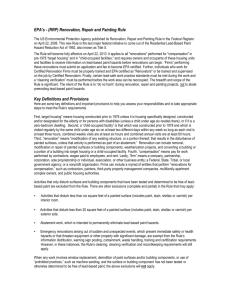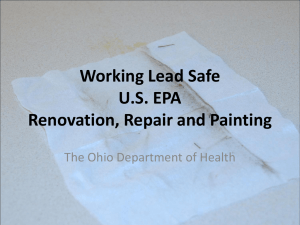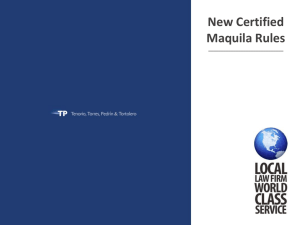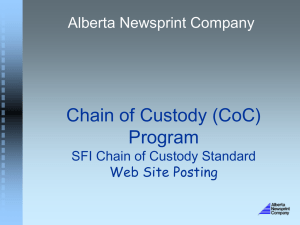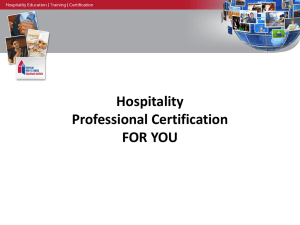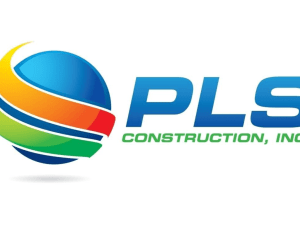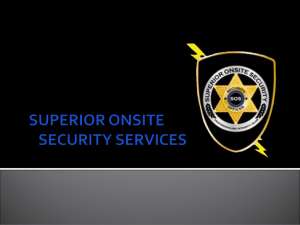Lead Safe powerpoint
advertisement
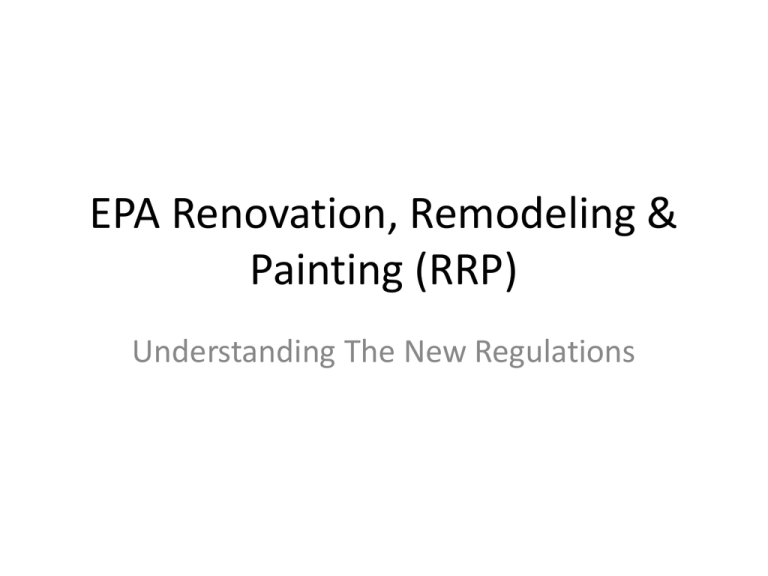
EPA Renovation, Remodeling & Painting (RRP) Understanding The New Regulations The RRP Rule •Addresses activities that disturb lead-based paint in target housing and child-occupied facilities. It requires: – – – – – Renovators to be certified through training; Firms to be certified; Training providers to be accredited; Lead-safe work practices during renovations; Pre-renovation education in target housing and child-occupied facilities. •On or after December 31, 2010, firms working in pre-1978 homes and child-occupied facilities must be certified and use lead-safe work practices during renovations. • EPA may authorize states, territories and tribes to enforce the Rule. Exclusions • Renovation activities where affected components do not contain lead-based paint; • Emergency renovations (requires cleanup and cleaning verification); • Minor repair and maintenance activities: less than 6 square feet interior or 20 square feet exterior (note: this exclusion does not apply to window replacement, demolition or activities involving prohibited practices); • Renovations performed by homeowners in their own homes; • Zero Bedroom Units or Designated Senior Housing. There is no longer an “Opt-Out” provision! Enforcement –EPA may suspend, revoke, or modify a firm’s certification if the Certified Firm or Certified Renovator is found to be in non-compliance. –Those firms found to be non-compliant may be liable for civil penalties of up to $32,500 for each violation. –Those firms who knowingly or willfully violate this regulation may be subject to fines of up to an additional $32,500 per violation, or imprisonment, or both. Firm Certification • On or after December 31, 2010, all covered renovations must be performed by Certified Firms, using Certified Renovators and other trained workers; • To become certified, firms must submit an application, and pay a fee, to EPA.; • Certifications will be good for 5 years; • Certification allows the firm to perform renovations in any non-authorized state or Indian tribal area (additional certification requirements may apply in these areas). Firm Responsibilities • Ensure overall compliance with the RRP Rule; • Ensure that all renovation personnel are Certified Renovators or have been trained onthe-job by Certified Renovators; • Assign a Certified Renovator to all jobs; • Meet pre-renovation education requirements; • Meet recordkeeping requirements. Individual Certification • To become a Certified Renovator, an individual must take an EPA-approved 8-hour training course from an EPAaccredited training provider. • The course completion certificate serves to certify renovators (no application to EPA is required). • Refresher training is required every 5 years. • Workers do not need certification so long as on-the-job training is received from a Certified Renovator and the work is not HUD-regulated. Certified Renovator Responsibilities • Perform work and direct lead-safe work practices. • Provide on-the-job training to non-certified workers. • Keep a copy of the initial and/or refresher training certificates onsite. • Use EPA-recognized test kits to identify lead-based paint. • Be physically present while posting signs, containing work areas, and cleaning work areas. • Be available by telephone when off-site. • Maintain the containment to keep dust and debris within the work area. • Implement the cleaning verification procedure. • Prepare and maintain required records. RRP: Small Entity Compliance Guide An overview of compliance with the RRP Rule for small businesses and sole proprietors. www.epa.gov/lead 1-800-424-LEAD (5323) RRP: Work Practice Standards The Renovation, Repair, and Painting Final Rule covers setup of the work area, prohibited work practices, cleanup and the cleaning verification procedure. – Setup practices, such as posting signs and containing the work area; – Containment and Prohibited Practices; – Cleanup practices and Cleaning Verification procedures; – Recordkeeping. Setup & Containment • “Containment” is a system of temporary barriers used to isolate a work area so that no dust or debris escapes while the renovation is being performed. – Limit access and post signs. – Remove (preferred) or cover belongings. – Cover floors. – Close and seal windows, doors and HVAC system. – Construct a work area entry doorway. Interior Containment Required: • Cover all work area floors with plastic sheeting. • Cover floors a minimum of 6 feet in all directions around the paint being disturbed. Recommended: • Lay plastic sheeting in high traffic areas. • Take special precautions for carpets. • Use a disposable tack pad at the edge of protective sheeting. • Vertical containment as necessary Exterior Containment • Cover the ground with protective sheeting. – If space permits, extend a minimum of 10 feet from the work area. – Play special attention and cover nearby vegetable gardens and children's play areas. • Limit access, place signs. – Establish a 20 foot perimeter around the work area if space permits. • Close all nearby doors and windows that are within 20 feet of the work area. • Use two layers of plastic sheeting on doors in the work area that are being used during the job. Safe Work Practices • A clean work site reduces the spread of dust and paint chips. • Clean as you work. – HEPA vacuum horizontal surfaces. – Remove debris frequently. – Remove paint chips as they are created. – As building components are removed, wrap and dispose of them immediately. • Clean frequently (in stages, at least daily). Prohibited Methods & Alternatives Prohibited Methods Open-flame burning or torching. Heat gun above 1100º F. Power sanding, power grinding, needle guns, abrasive blasting and sandblasting, without HEPA vacuum attachment. Alternative Solutions – “Work Wet” – hand scraping and sanding w/ a misting bottle. – Power tools with HEPAfiltered capture attachments. – Pneumatic and battery powered tools to protect against shock hazards. – Specialized planning and containment. Cleanup & Cleaning Verification • HEPA vacuum all vertical and horizontal areas • Two feet beyond work area • All work areas should be clear of dust and debris • Certified Renovators conduct their own Cleaning Verification • Clearance Testing is optional Recordkeeping On The Worksite • Renovator Certification • Firm Certification • Non-certified worker training documentation • Test Kit Results (optional) • Renovate Right – proof of receipt by owner and/or tenant notification At The Office • All worksite documentation • Report verifying compliance with RRP protocol • Clearance Test results, if applicable • All worksite documentation must be kept for 3 years after the renovation Supply List • • • • • • • • • • • • Signs Barrier Tape Cones Plastic Sheeting Tape Stapler Utility Knife Wet/Dry Sandpaper Misting Bottle or Pump Sprayer HEPA Vacuum Heavy-Duty Plastic Bags Tack Pads • • • • • Low-Temperature Heat Gun Power Tools w/ HEPA Attachment Disposable Wet Cleaning Wipes Detergent or Cleaning Solution LEADFLYER.doc
